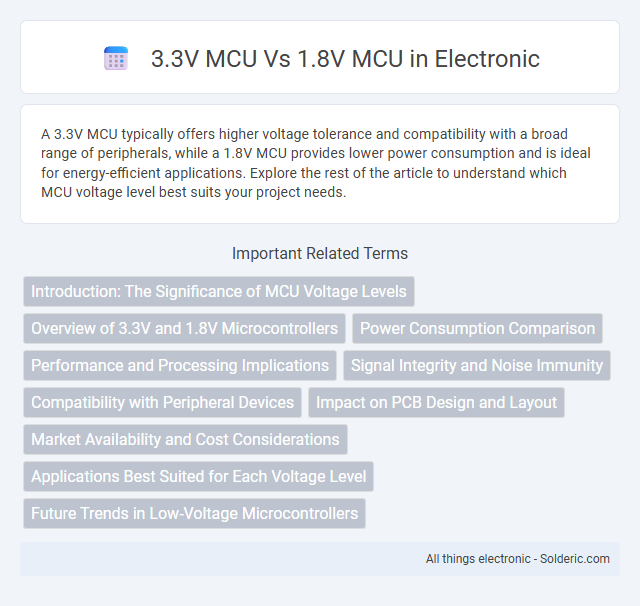A 3.3V MCU typically offers higher voltage tolerance and compatibility with a broad range of peripherals, while a 1.8V MCU provides lower power consumption and is ideal for energy-efficient applications. Explore the rest of the article to understand which MCU voltage level best suits your project needs.
Comparison Table
| Feature | 3.3V MCU | 1.8V MCU |
|---|---|---|
| Operating Voltage | 3.3 Volts | 1.8 Volts |
| Power Consumption | Higher power consumption | Lower power consumption, ideal for low-power devices |
| Speed | Typically supports higher clock speeds | May have limitations on max clock speed |
| I/O Compatibility | Compatible with 3.3V peripherals | Compatible with 1.8V peripherals, may require level shifting for 3.3V |
| Noise Margin | Higher noise margin | Lower noise margin, more sensitive to voltage variations |
| Applications | Industrial, general purpose | Battery-powered, portable, wearable devices |
| Thermal Dissipation | Higher thermal output | Lower thermal output |
Introduction: The Significance of MCU Voltage Levels
MCUs operating at 3.3V typically offer greater GPIO compatibility and higher noise immunity compared to 1.8V MCUs, which excel in lower power consumption and compact system design. Your choice impacts interfacing with sensors, memory, and communication modules that often require specific voltage levels for optimal performance. Selecting the appropriate MCU voltage level ensures efficient power management and seamless integration within your embedded system.
Overview of 3.3V and 1.8V Microcontrollers
3.3V microcontrollers offer a broad compatibility with a range of sensors and peripherals commonly used in industrial and consumer electronics due to their higher operating voltage, which supports wider input/output interfacing. In contrast, 1.8V microcontrollers emphasize low power consumption and are ideal for battery-operated and wearable devices, benefiting from reduced voltage levels that minimize energy usage and heat dissipation. The choice between 3.3V and 1.8V MCUs depends heavily on the application's power requirements, signal level compatibility, and peripheral integration needs.
Power Consumption Comparison
3.3V MCUs typically consume more power due to higher voltage operation, which increases dynamic power dissipation proportional to V2. In contrast, 1.8V MCUs achieve significantly lower power consumption, making them ideal for battery-powered and energy-sensitive applications. The reduced voltage on 1.8V MCUs enhances energy efficiency and extends device runtime, crucial in IoT and portable electronics.
Performance and Processing Implications
3.3V MCUs often deliver higher clock speeds and improved processing performance compared to 1.8V MCUs due to their ability to handle greater voltage headroom, which supports faster transistor switching. Lower voltage 1.8V MCUs emphasize power efficiency and reduced heat dissipation, sometimes trading off peak processing capabilities for extended battery life and smaller device footprints. Designers choose between 3.3V and 1.8V MCUs based on requirements for computational power versus energy consumption, impacting system-level performance and thermal management strategies.
Signal Integrity and Noise Immunity
A 3.3V MCU typically offers better signal integrity and noise immunity compared to a 1.8V MCU due to its higher voltage swing, which improves the signal-to-noise ratio and reduces susceptibility to electromagnetic interference. Lower voltage MCUs often require more careful PCB layout and shielding techniques to maintain reliable signal transmission, especially in noisy environments. Your choice between 3.3V and 1.8V MCUs should consider the trade-off between power consumption and the robustness of signal integrity required for the application.
Compatibility with Peripheral Devices
3.3V MCUs offer greater compatibility with a wide range of peripheral devices, as many sensors, communication modules, and other components are designed to operate at or near the 3.3V standard. In contrast, 1.8V MCUs may require level shifters or voltage translators to interface with peripherals operating at higher voltages, adding complexity to the design. Choosing a 3.3V MCU can simplify integration and reduce the need for additional components, enhancing the reliability of Your system.
Impact on PCB Design and Layout
3.3V MCUs typically require larger voltage regulators and more robust power traces on the PCB, impacting board size and thermal management. In contrast, 1.8V MCUs enable smaller power supply components and narrower traces, allowing for denser and more compact PCB layouts. Your choice affects signal integrity and power distribution strategies, especially when interfacing with peripherals operating at different voltage levels.
Market Availability and Cost Considerations
3.3V MCUs dominate market availability due to widespread support from numerous manufacturers, ensuring a broad selection of peripherals and development tools. They generally offer lower costs driven by mature production processes and extensive adoption in consumer electronics. In contrast, 1.8V MCUs, designed for low-power and advanced applications, tend to be pricier and less prevalent but are crucial for emerging IoT and wearable devices requiring minimal power consumption.
Applications Best Suited for Each Voltage Level
3.3V MCUs are best suited for applications requiring higher peripheral compatibility, such as interfacing with sensors, displays, and communication modules that operate at standard logic levels, commonly found in industrial automation and automotive systems. 1.8V MCUs excel in ultra-low-power applications like wearable devices, IoT sensors, and battery-operated gadgets where energy efficiency is critical to extend battery life. Selecting the appropriate voltage level depends on balancing power consumption, peripheral interface requirements, and system design constraints.
Future Trends in Low-Voltage Microcontrollers
Future trends in low-voltage microcontrollers highlight a shift from traditional 3.3V MCUs to more energy-efficient 1.8V MCUs, driven by increasing demand for extended battery life in IoT and wearable devices. Advances in semiconductor technology enable 1.8V MCUs to deliver comparable processing power while significantly reducing power consumption and heat generation. The adoption of ultra-low-voltage MCUs supports the growth of edge computing and AI applications, emphasizing the importance of optimizing performance-per-watt metrics.
3.3V MCU vs 1.8V MCU Infographic

 solderic.com
solderic.com